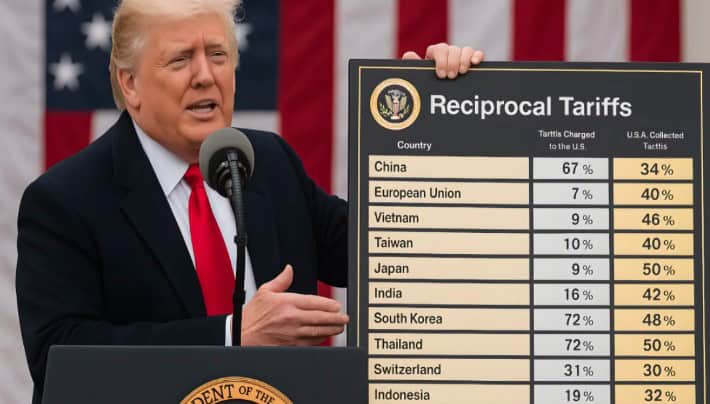On 2 April 2025, the Trump administration declared a “national emergency” caused by “large and persistent US goods trade deficits” and announced the imposition of new “reciprocal tariffs” using powers granted to the president under the International Emergency Economic Powers Act. This column argues that the tariffs do not meet two core requirements for the exercise of emergency powers under the Act – that measures are needed to respond to an “unusual and extraordinary threat” originating abroad, and that the measures undertaken must “deal with” that threat. Moreover, the text of the Act does not contain a clear delegation of sweeping tariff authority to the president.
On 2 April 2025, US President Trump issued an Executive Order declaring a “national emergency,” which stated that “large and persistent US goods trade deficits” have caused a “hollowing out” of US manufacturing and a loss of manufacturing jobs, resulting in threats to national security, critical supply chains, and the defence industrial base. The President’s Executive Order went on to suggest that the merchandise trade deficit was increasing at an alarming rate and was caused “in substantial part by a lack of reciprocity in our bilateral trade relationships” (The White House 2025). To address the declared emergency, the President announced the imposition of new “reciprocal tariffs”, consisting of a baseline tariff on all merchandise imports, and additional tariffs ranging up to 50% on goods from countries with which the US runs a bilateral merchandise trade deficit. Under the President’s formula, the tariff rate increase for each country was set equal to the ratio of the merchandise trade deficit with that country to the total value of imports from it, subject to a minimum rate hike of 10%.
The tariffs were imposed using emergency powers given to the President under the International Emergency Economic Powers Act (IEEPA), which empowers the President, after a national emergency declaration, to undertake measures “to deal with any unusual and extraordinary threat, which has its source in whole or substantial part outside the United States, to the national security, foreign policy, or economy of the United States”. A variety of private and public sector plaintiffs sued in response, arguing that IEEPA does not authorise the reciprocal tariffs. These lawsuits were successful in courts of first instance including the Court of International Trade. The Federal Circuit Court of Appeals subsequently affirmed that decision in a 7-4 ruling declaring the tariffs to be unlawful under IEEPA. The matter is now on expedited appeal before the US Supreme Court, with oral argument scheduled for 5 November.
In a recent paper (Grossman and Sykes 2025), we offer an economic and historical perspective on the reciprocal tariffs, their rationale as stated in the Executive Order, and the question of whether the US Congress would plausibly have intended to delegate to the President through IEEPA the power to impose the sweeping reciprocal tariffs. We focus on the parochial case for tariffs from the US perspective and put to one side the harm done to US trading partners for present purposes.
In brief, we conclude that the rationale for the tariffs is economically incoherent, and that the reciprocal tariffs are not rationally connected to any conceivable “emergency” in the US manufacturing sector, assuming arguendo that one exists. Accordingly, two core requirements for the exercise of emergency powers under IEEPA – that measures are needed to respond to an “unusual and extraordinary threat” originating abroad, and that the measures undertaken must “deal with” that threat – are not met. We further argue, based on the historical relationship between Congress and the President in trade policy formulation, that the emergency powers granted by IEEPA could not have been intended to permit the President to rewrite the entire US tariff schedules, painstakingly negotiated over three quarters of a century, by simply declaring an “emergency” based on nebulous assertions of difficulties in the manufacturing sector.
Beginning with the claim in the Executive Order that the US merchandise trade deficit is a burgeoning problem, “having grown by over 40% in the last five years alone,” the data present quite a different picture when properly interpreted. Most of the nominal growth in the deficit can be explained by inflation and the growth of the economy. The deficit as a percentage of GDP rose from 3.98% in 2019 to 4.16% in 2024. To place these levels in historical context, the deficit to GDP ratio was at a maximum in 2006, at 5.7%.
As for the claim that merchandise trade deficits are caused by a lack of bilateral reciprocity in trade relations, and the further statement that “despite a commitment to the principle of reciprocity, the trading relationship between the United States and its trading partners has become highly unbalanced, particularly in recent years”, the supporting evidence presented in the Executive Order consists of a few anecdotes regarding the tariff rates on individual items in the US and elsewhere, along with some scattered statistics about differences across a handful of countries in their “simple average tariff rates”. The discussion ignores the reality that there is no reason to expect bilateral trade to balance between pairs of countries that have different preferences on the consumer side and different areas of comparative advantage. Bilateral imbalances are ordinary features of a multilateral trading system and not indicative of asymmetric trade barriers.
Moreover, throughout the history of WTO/GATT negotiations, a norm of reciprocity was observed so that each party expected their aggregate exports to increase by an amount roughly equal to their aggregate imports following each liberalisation episode. The US State Department undertook calculations during negotiating rounds to confirm that US concessions were approximately reciprocated in this sense (Bagwell et al. 2020). And the Executive Order presents no evidence that US free trade agreements negotiated since the formation of the WTO (including agreements negotiated in the first Trump administration with Canada, Mexico and Korea) are the source of asymmetric trade barriers.
Finally, as a net borrower nation over the past four decades – with total investments exceeding national savings – US current account deficits are inevitable. Given the persistent surplus in services trade, a sizeable merchandise trade deficit is likewise unavoidable.
More fundamentally, the Executive Order’s claim that merchandise trade deficits have “led to” problems in the manufacturing sector reflects a misunderstanding of cause and effect. Merchandise trade deficits are endogenous, as are manufacturing output and employment; neither can meaningfully “lead to” the other. Rather, both reflect underlying economic forces that simultaneously influence manufacturing performance and the trade balance. For example, Kehoe et al. (2018) provide evidence that the loss of manufacturing jobs in the United States has been largely attributable to productivity growth.
Thus, the economic foundation for the assertion of a manufacturing “emergency” is theoretically and empirically unsound. Although the Executive Order claims that a growing lack of reciprocity has caused burgeoning merchandise trade deficits, and that those deficits in turn have caused vaguely specified problems in the US manufacturing sector that are so exigent as to constitute an “emergency”, facts and logic undermine each step in that chain of reasoning. Given the dubious underpinning of the national emergency declaration, the Executive Order fails to identify an “unusual and extraordinary threat” originating outside the United States that warrants any measures under IEEPA.
Even setting this conclusion aside and assuming arguendo that some circumstances in the manufacturing sector could warrant an “emergency” designation, the reciprocal tariffs do not constitute a coherent response. Moreover, they are unlikely to achieve any meaningful “rebalancing” of US merchandise trade, contrary to the tariffs’ stated objective.
The assertions in the Executive Order regarding the “hollowing out” of manufacturing, threats to national security and critical supply chains, and the like provide no specifics. They do not identify the firms or industries purportedly affected, making it impossible to assess whether the reciprocal tariffs could plausibly address these problems. Rather than offering targeted relief to manufacturers facing genuine emergency conditions, the tariffs resemble a randomised tax on all imported goods, applied according to factors with no clear connection to those conditions. Any constructive response to an actual “emergency” would occur entirely by coincidence.
Meanwhile, many of the tariffs will harm US manufacturers. They apply to all products, including intermediate goods, and have already been linked to significant reductions in profitability for some firms, such as General Motors. The discriminatory design of the reciprocal tariffs can also trigger costly supply chain restructuring and the abandonment of valuable sunk investments abroad. Retaliation by trading partners – such as China’s retaliatory tariffs, reduced purchases of US agricultural exports, and restrictions on rare earth exports – has unquestionably created difficulties for US firms in both manufacturing and agriculture.
It is far from clear that the tariffs will materially reduce US merchandise trade deficits or “rebalance” US merchandise trade, the stated objective of the measures, since they do not address the macroeconomic imbalances at their root. Moreover, pursuing such rebalancing is largely misguided from the outset. The mainstream view among economists holds that trade policy has little effect on the current account balance. If that view is correct, any insipient rebalancing of merchandise trade is likely to be offset by reduced US net exports of services – an area in which the US is technologically advanced and enjoys a clear comparative advantage.
Some recent research suggests that trade policy can affect current account balances under certain conditions (Costinot and Werning 2025). This possibility underscores the link between the merchandise trade balance and net inbound investment. The Trump administration has promoted various “deals” promising new foreign investment in the US manufacturing sector, involving both national governments (such as Japan and Korea) and private firms (such as Taiwan Semiconductor and Roche). Any additional net inbound foreign investment must, of course, be financed, which requires an increased current account deficit and, in all likelihood, growth in the merchandise trade deficit. Rebalancing on one hand, and new foreign investment in US manufacturing on the other, are thus inherently at odds.
For all these reasons, the reciprocal tariffs do not meaningfully “deal with” any emergency conditions that might plausibly exist in the US manufacturing sector, as is required by IEEPA. There is no reason to believe that the tariffs will mitigate serious challenges facing US manufacturing firms, or that any “rebalancing” of US merchandise trade would be constructive.
Finally, a core issue before the Supreme Court is whether IEEPA, with its vague language regarding the President’s power to “regulate…importation” in an emergency, can reasonably be interpreted to permit the sweeping revision of US tariff schedules and the accompanying repudiation of US commitments under international trade agreements undertaken by the Trump administration. The US Constitution explicitly grants the power to set tariffs and regulate foreign commerce to Congress under Article I. Under the Supreme Court’s “major questions” doctrine, a statute must provide a clear and unambiguous delegation of authority before it will be interpreted to allow the Executive Branch to act alone on matters of “vast economic and political significance”. There is no doubt that US tariff policy qualifies as a “major question” and, consistent with other commentators, we believe that the text of IEEPA does not contain a clear delegation of sweeping tariff authority.
We further note, based on the history of US trade policy and the interaction between the President and Congress, that any Congressional intent to delegate sweeping tariff authority is highly implausible. Congress has zealously guarded its authority over tariffs and other aspects of trade policy by requiring the President to negotiate with Congress in advance of major trade negotiations to obtain “fast track” or “trade promotion authority”, specifying negotiating objectives and limiting the tariff changes the President may make in exchange for an up-or- down vote on any resulting agreement.
Moreover, Congress has enacted several statutes granting the Executive Branch authority to address trade-related challenges to US industries, including safeguard measures, national security protections, and remedies for “unfair” trade practices abroad that burden U.S. commerce. These statutes are sufficiently broad to address the types of problems identified by the Executive Order in the manufacturing sector. All require agency investigations and public findings establishing that the statutory conditions for Executive action have been met, along with an explanation of how any new trade measures directly respond to the underlying problem. It strains credulity to imagine that Congress would intend for these procedural and substantive standards to be waived, potentially indefinitely, merely because the President is willing to declare an “emergency”.
Source : VOXeu





